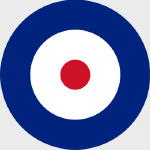Corgi AA36514 RAF Hawker Typhoon Mk. Ib Ground Attack Aircraft - 'JB II', John R Baldwin, No.193 Squadron, No.146 Wing, June 1944 (1:72 Scale)
"Aera et Terram Imperare" ("To govern the air and the earth")
- Motto of No.193 Squadron
 The Typhoon was a British single-seat strike fighter, produced by Hawker Aviation starting in 1941. Intended as a replacement for the Hawker Hurricane in the interceptor role, it suffered from performance problems, but eventually evolved into one of World War II's most successful ground attack aircraft.
The Typhoon was a British single-seat strike fighter, produced by Hawker Aviation starting in 1941. Intended as a replacement for the Hawker Hurricane in the interceptor role, it suffered from performance problems, but eventually evolved into one of World War II's most successful ground attack aircraft.
Even before the new Hurricane was rolling off the production lines in March 1937, Sidney Camm had moved on to designing its future replacement as a private project. This was to be a massive plane designed around the equally massive Napier Sabre engine. The work proved useful when Hawker received specification F.18/37 in January 1938 from the Air Ministry, which asked for a fighter based around either the Napier Sabre or the Rolls-Royce Vulture engine. The engines were similar in that they were both 24 cylinder designs that were designed to deliver over 2,000 hp (1.5 MW), and different primarily in the arrangement of the cylinders - an H-block in the Sabre and an X-block in the Vulture.
The two resulting models became known as the 'R' and 'N' (based on the engine manufacturer) and were very similar - the Vulture powered R plane had a rounder nose profile and a ventral radiator, whereas the Sabre powered N had a flatter deck and a chin mounted radiator. The basic design of both continued the Hawker tradition of using 'older' construction techniques; the front fuselage was welded steel just like the Hurricane, and the design used a massive 40 foot (12 m) wing that was much thicker than those on designs like the Spitfire. Camm did give in to the times for much of the rest of the plane though; it was semi-monocoque from the cockpit rearward, flush riveted, and had wide set gear. Instead of sliding or lifting canopy the Typhoon came with a side door.
The R version first flew in October 1939, and the RAF was so impressed they ordered 1,000 as the Tornado. Various problems, notably compression effects which were previously unknown to Hawker, slowed the acceptance down. In addition the plane had rather disappointing climb performance, which meant it wouldn't be the Spitfire-replacing interceptor they were looking for. In February 1940 the first N model, now known as the Typhoon, was delivered. The RAF placed a large order for it as well, but moved production to Gloster Aircraft who had no designs to produce at the time. Like the Tornado, the Typhoon was soon demonstrating its own problems, including vibrations from the engine causing the wing's skin to peel.
Eventually the RAF cancelled all work on both models in May 1940 so that Hawker could concentrate solely on the Hurricane during the Battle of Britain. This was the design's first brush with death. Some small-scale work continued, changes to streamline the fuselage and supply a much thinner wing were looked at, as well as alternate engines in the form of large radials. In October pressure on the RAF eased and work was allowed to continue on the two original designs.
The first full production version Tornado was delivered in early 1941 and demonstrated the then unheard of speed of 425 mph fully armed. This was also the last Tornado. While production lines were being drawn up, the Vulture engine project was suddenly terminated by Rolls-Royce and the Tornado was left without an engine. However the Typhoon had 'good enough' performance to warrant production. The first production Mk.IA was delivered in May 1941 with twelve Browning .303 guns, but this was followed quickly with the Mk.IB with four Hispano 20 mm cannons.
This particular 1:72 scale aircraft was flown by John R Baldwin, who was attached to No.193 Squadron, No.146 Wing, during June 1944.
Pre-order! Ship Date: Summer 2024.
Dimensions:
Wingspan: 7-inches
Length: 5-1/4-inches
Release Date: ?
Historical Account: "Typhoon Ace" - By the end of his first tour of duty in April 1944, pilot John Robert Baldwin had amassed at least 13 aerial victories, having flown an incredible number of missions supporting pre-D-Day operations in his trusty Hawker Typhoon. He would return to operational flying after taking a short break, having been promoted to the position of Wing Commander RAF No.146 Wing, again flying Typhoons and again embarking on a punishing schedule of flight operations, this time in support of the Allied ground advances through France and missions against V-1 Doodlebug sites.
Leading the entire Wing on at least sixteen occasions, Baldwin's logbook shows at least 110 sorties flown in support of these missions, with other official records suggesting that figure should be closer to 170, as this Wing Commander was determined to lead his men from the front during these dangerous missions. Baldwin's reputation was such that he was assigned at least two Typhoons, each configured for different missions.
One was equipped with bombs, whilst the one referred to as 'JBII' sported the rocket projectiles RAF Hawker Typhoons became so famous for using. One wartime picture shows two of Baldwin's Typhoons parked next to each other, which is a fascinating record of this ace pilot's wartime contribution. John Robert Baldwin would end the war as the highest-scoring Hawker Typhoon 'Ace', with 15 confirmed victories, 1 shared and 4 probables to his name.


